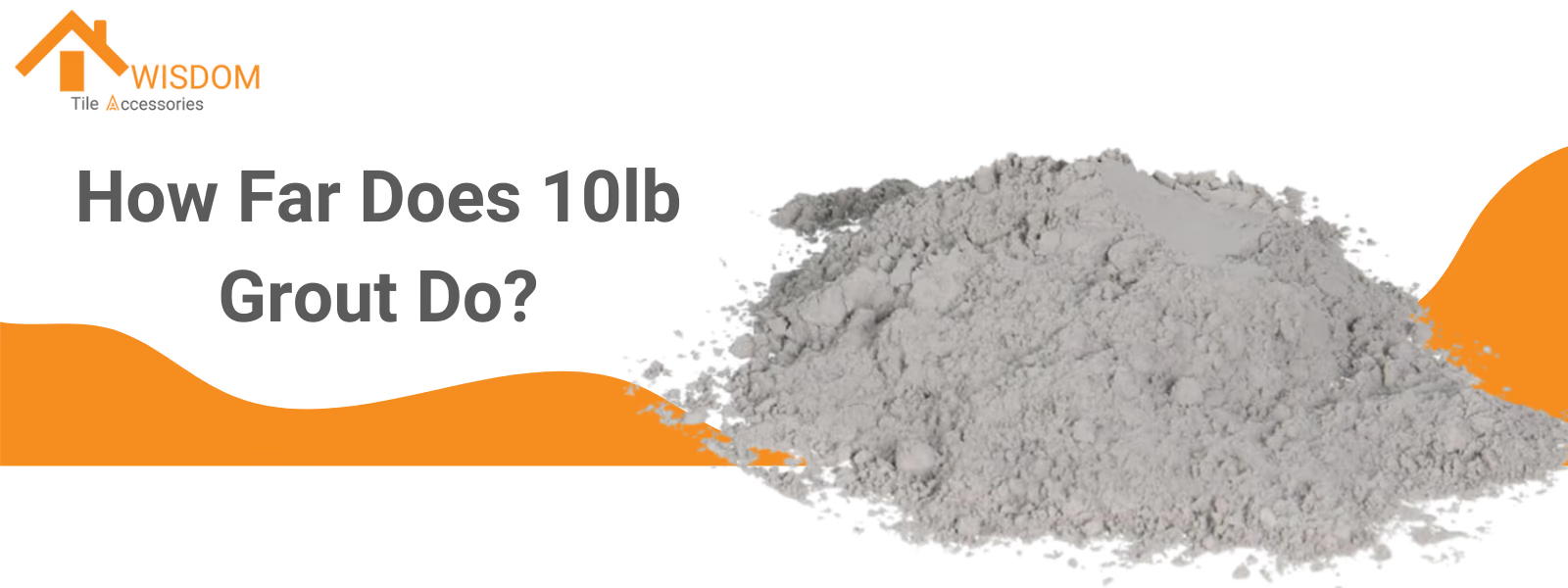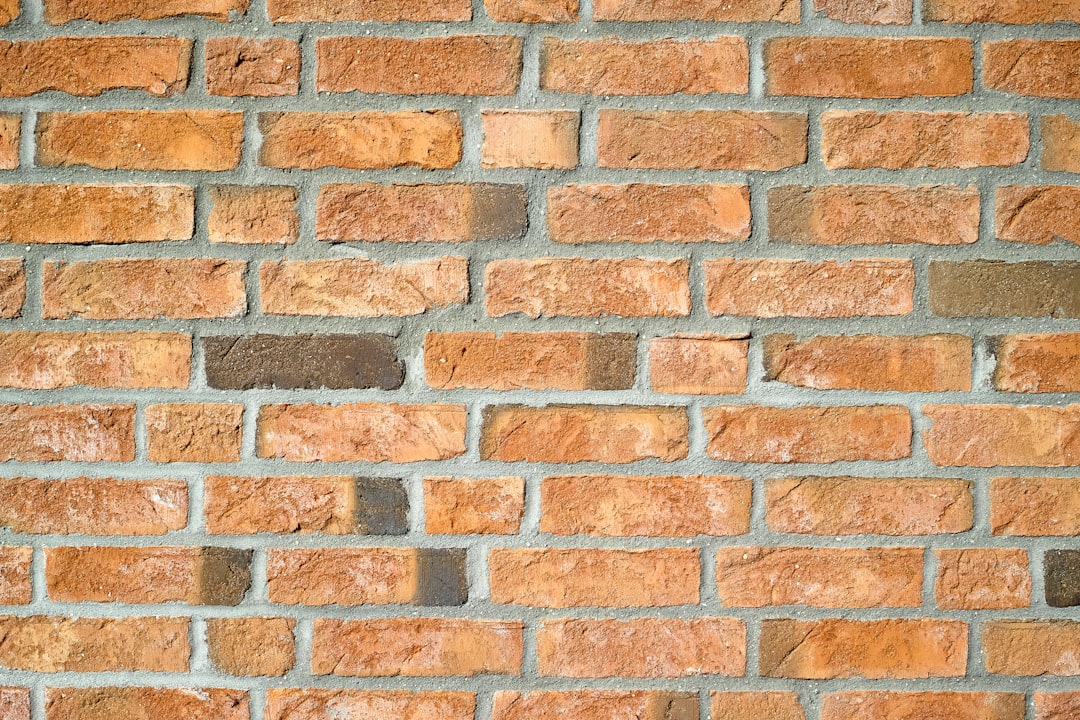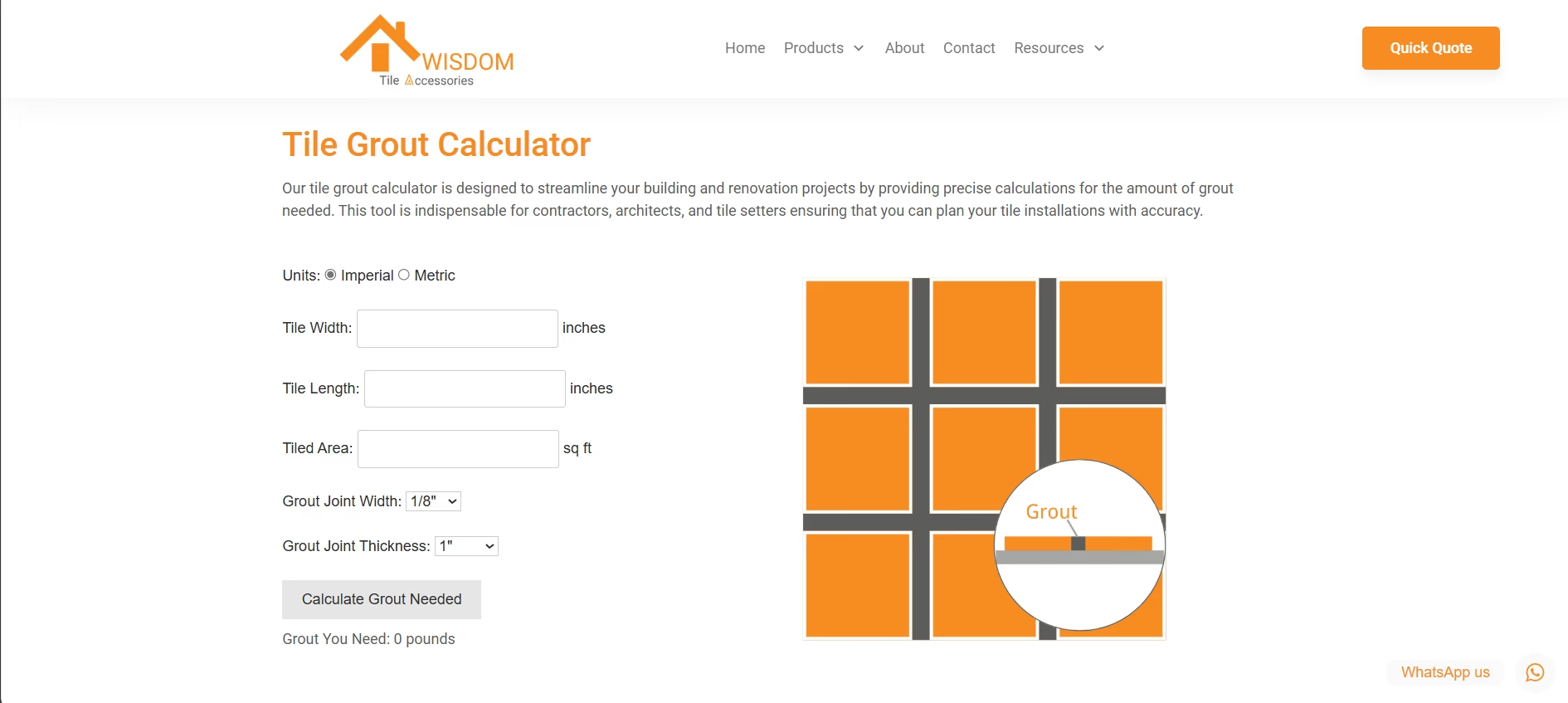How far does 10lb grout do? That’s the question you’re here to answer. The short answer is that 10 pounds of grout typically covers between 50 and 100 square feet—but the exact number depends on your project.
Are you using large 12"x12" tiles with narrow grout lines? You might stretch a single bag to cover almost 100 square feet. On the other hand, if you’re working with smaller tiles or wider gaps, the same bag might only handle half that area.

The truth is, grout coverage isn’t one-size-fits-all. Factors like tile size, grout line width, and tile thickness all play a role. Without planning ahead, you risk running out mid-project—or buying far more grout than you’ll actually need.
This guide is here to take the guesswork out of the process. We’ll show you exactly how to estimate grout coverage for your specific project, provide real examples, and share practical tips to save time and money. By the end, you’ll know exactly whether a 10lb bag of grout is enough for your tiling job.
What You Need to Know About 10lb Grout Coverage
The Short Answer
When it comes to grout coverage, a 10lb bag typically handles between 50 and 100 square feet of tiled area. However, this number isn’t carved in stone—it changes based on the specifics of your project. The size of your tiles, the width of your grout lines, and even the thickness of the tiles can dramatically shift how far that bag of grout will stretch.
Let’s break it down with some real-world examples:
- Large tiles (12"x12") with narrow grout lines (1/8 inch): Expect up to 90-100 square feet of coverage.
- Smaller tiles (6"x6") with wider grout lines (1/4 inch): Coverage drops to around 50-60 square feet.
- Mosaic tiles (2"x2") with narrow grout lines (1/8 inch): You might only cover 40 square feet due to the high number of grout lines.
This range is important to understand, as running out of grout mid-project can delay your work, while buying too much leads to unnecessary expense and waste.
Why Coverage Varies
Grout coverage isn’t a universal number because several factors interact to determine how much material your project requires. Let’s look at these variables more closely:
Tile Size
Tile size is one of the biggest factors. Larger tiles mean fewer seams and, therefore, less grout. Smaller tiles, on the other hand, create more seams and require significantly more grout to fill.
- Larger Tiles (e.g., 12"x12"): These tiles result in fewer grout lines per square foot, so your grout stretches further.
- Smaller Tiles (e.g., 2"x2"): The sheer number of grout lines adds up, increasing grout consumption dramatically.
Grout Line Width
The width of your grout lines—the space between tiles—is another major variable. Wider lines require more grout, while narrower lines use less.
- Narrow Grout Lines (1/16" to 1/8"): These are more efficient and allow you to get more coverage out of a single bag.
- Wide Grout Lines (1/4" or larger): These demand significantly more grout, reducing overall coverage.
Tile Thickness
Thicker tiles lead to deeper grout lines, which means more grout is needed to fill the gaps.
- Standard Ceramic Tiles: These are typically thinner, so grout usage is minimal.
- Natural Stone or Thick Porcelain Tiles: The added thickness increases the volume of grout required, especially for wider lines.
Type of Grout
The type of grout you choose also impacts coverage:
- Sanded Grout: Commonly used for wider gaps (>1/8 inch). It’s denser, which may slightly reduce coverage compared to unsanded grout.
- Unsanded Grout: Designed for narrower gaps (≤1/8 inch) and tends to go further per pound.
Quick Reference Table
Here’s a quick look at how tile size and grout line width impact coverage. Use this as a starting point for estimating your needs:
Tile Size | Grout Line Width | Coverage (10lb) |
|---|---|---|
12"x12" | 1/8" | ~90-100 sq. ft. |
6"x6" | 1/4" | ~50-60 sq. ft. |
2"x2" | 1/8" | ~40 sq. ft. |
This table assumes standard tile thickness and sanded grout. If your project involves non-standard tiles, particularly thick materials, or unique grout lines, these numbers may vary.

How to Calculate Grout Needs
Breaking It Down
Estimating how much grout you’ll need for a project can feel overwhelming at first, but it becomes much simpler when broken down into steps. A clear understanding of how tile size, grout line width, and tile thickness interact will help you calculate the exact amount you need. Here’s the key formula:
Grout Needed = (Grout Line Width × Tile Thickness × Total Grout Line Length) ÷ Coverage Factor
Let’s make this easier by explaining each part of the formula in practical terms:
- Grout Line Width: This is the space between your tiles, typically measured in inches (e.g., 1/16", 1/8", or 1/4"). Wider grout lines require more material.
- Tile Thickness: The depth of your tiles, which determines how much grout is needed to fill the gap. Standard ceramic tiles are thinner than natural stone, which increases grout usage.
- Total Grout Line Length: The combined length of all the grout lines in your project. For square or rectangular tiles, this can be calculated based on the tile size and total surface area.
- Coverage Factor: This is the efficiency of the grout, usually provided on the packaging. For example, a 10lb bag of grout may cover 230 cubic inches of volume.
This formula gives you a starting point for estimation, but it’s not the whole story. Factors like wastage, irregularly shaped spaces, and unplanned mistakes need to be accounted for.
Step-by-Step Example
Let’s apply this formula to a real-world example. Imagine you’re tiling a 100 square foot bathroom floor with 12"x12" ceramic tiles and using 1/8" grout lines.
Step 1: Calculate the Total Grout Line Length
- Each 12"x12" tile has four edges, each 12 inches long. For 100 square feet, you’ll use 100 tiles.
- Total grout line length = 4 edges × 12 inches × 100 tiles = 4,800 inches.
Step 2: Calculate the Grout Volume Per Inch
- Grout volume for each inch of grout line = Grout Line Width × Tile Thickness.
- For this project: Grout Line Width = 1/8" (0.125 inches) and Tile Thickness = 0.3 inches.
- Volume per inch = 0.125 × 0.3 = 0.0375 cubic inches.
Step 3: Calculate Total Grout Volume
- Total grout volume = Total Grout Line Length × Volume Per Inch.
- For this project: 4,800 inches × 0.0375 cubic inches = 180 cubic inches.
Step 4: Convert to Grout Weight
- Referencing the grout packaging, let’s say a 10lb bag of grout covers 230 cubic inches.
- Total weight needed = Total Volume ÷ Coverage Factor × Weight of the Bag.
- For this project: 180 ÷ 230 × 10lb = 7.8lb.
Final Result:
You’ll need slightly under 10lb of grout for this project. To account for errors or wastage, it’s wise to buy an additional 10-15%, so one 10lb bag will comfortably cover this job.
Simplify with Tools
Grout calculations can sometimes feel overwhelming, especially for irregularly shaped areas or projects with intricate tile layouts. Fortunately, grout calculators make the process faster and more accurate, removing much of the guesswork. Here’s how you can simplify your planning with the right tools:

Start with the Awisdom Tile Accessories Grout Calculator
If manual calculations feel like a hassle, try using the Awisdom Tile Accessories Grout Calculator. It’s designed to give you precise results in just a few steps. Whether you’re working on a small bathroom or a large kitchen floor, this tool streamlines your project planning by helping you estimate grout needs quickly and accurately.
- When to Use It: The calculator is particularly helpful for larger tiled areas or projects with unique grout line widths and tile dimensions. For example, tiling a 150 sq ft open kitchen floor with 12"x12" tiles and 1/8" grout lines becomes much easier when you let the calculator do the work.
- How It Works: Simply input your tile width, length, total area, grout line width, and joint thickness. The calculator instantly provides the amount of grout required, saving you from manual miscalculations.
- Why It Helps: By providing precise estimates, the calculator reduces the risk of running out of grout mid-project or overbuying materials.
Try it now: Awisdom Tile Accessories Tile Grout Calculator
Other Trusted Options
In addition to the Awisdom calculator, you might find other industry-standard tools helpful:
- Mapei Coverage Calculator: Known for its accuracy, this tool allows you to input tile dimensions and grout specifics for quick estimates.
- TEC Grout Coverage Calculator: With options to customize for different grout types, it’s a versatile solution for professional tilers.
Pro Tip
Whichever calculator you use, always round up slightly from the suggested grout quantity to account for wastage or unexpected adjustments during installation. For areas with intricate tile designs or irregular shapes, tools like these can save significant time and effort.
Practical Tips for Maximizing Coverage
Even with precise calculations, grout usage in real-life scenarios often varies due to waste, application errors, and the unique characteristics of your project. These practical tips will help you get the most out of your materials.
Prepare Wisely
Grout is a material that sets quickly, and preparation is key to minimizing waste:
- Mix Small Batches: Grout hardens within 20-30 minutes, so only mix what you can use in that time. A smaller batch prevents unnecessary waste.
- Plan for Wastage: Even professionals account for a 10-15% material loss due to spills, over-application, or grout left in tools. Always purchase a little extra grout to avoid shortages during the project.
- Organize Your Work Area: Before mixing, lay out your tools and map out the sections you’ll work on to streamline the process.
Use the Right Tools
Using proper tools can make a significant difference in grout application, improving efficiency and reducing waste. Here’s what you’ll need:
- Rubber Float: This tool helps you spread grout evenly across the tiles while pressing it into the joints. Use a 45-degree angle for best results.
- Margin Trowel: Ideal for mixing grout in small batches and applying it to corners or tight spaces.
- Grout Sponge: A high-quality sponge ensures efficient cleaning of excess grout from tile surfaces without removing material from the joints.
These tools are not just about saving grout; they also contribute to a cleaner, more professional finish.
Don’t Skimp on Material
Running out of grout mid-project can disrupt your workflow and result in visible inconsistencies. Avoid this issue with these tips:
- Buy Extra Material: Always purchase at least 10-15% more grout than your calculations suggest. This accounts for wastage and ensures consistency in color and texture.
- Match Batch Numbers: If your project requires multiple bags of grout, ensure they come from the same batch to avoid slight variations in color.
- Store Leftovers Correctly: Grout that hasn’t been mixed can be sealed in an airtight container and stored in a dry place for future touch-ups.
Scenarios Where 10lb Grout Works Best
Choosing the right size grout bag can be tricky, but a 10lb bag is often the perfect balance for small to medium tiling projects. It’s versatile enough to handle common home improvement jobs without unnecessary waste. Let’s dive into scenarios where a 10lb bag truly shines, along with tips to help you get the most out of it.
Small Spaces
A 10lb bag is ideal for tiling projects in compact areas. These jobs typically involve a manageable amount of grout, with minimal risk of running out or having excessive leftovers. Here are a few examples:
- Bathroom Floors: A standard 5’x5’ bathroom floor (25 square feet) tiled with 12"x12" tiles and narrow 1/8" grout lines requires less than half a 10lb bag. This leaves plenty for touch-ups or adjoining areas like a small closet or shower threshold.
- Kitchen Backsplashes: A backsplash measuring 15-20 square feet with mosaic tiles or subway tiles is a great match for a 10lb bag. The smaller tile sizes increase grout usage, but one bag is usually sufficient.
- Shower Walls: A typical shower with three tiled walls (approximately 36 square feet total) can also be completed comfortably with a single bag, assuming standard grout lines and tile sizes.
Pro Tip: Always calculate based on your specific tile and grout line dimensions to ensure accuracy. Buying slightly extra ensures you won’t run out in case of unexpected wastage.
Repairs and Touch-Ups
For minor fixes or partial re-grouting, a 10lb bag may be more than you need. However, if smaller bags aren’t available or you anticipate future projects, it’s still a practical option.
- Filling Missing Grout Lines: A few gaps in the grout due to wear and tear? You’ll only use a fraction of a 10lb bag, leaving plenty for future repairs.
- Re-Grouting Small Sections: Touching up a 2’x2’ area of a backsplash or floor tile requires minimal grout. In such cases, smaller bags (e.g., 2.5lb or 5lb) may be more convenient.
- Color Matching: If you’re repairing or replacing grout in a small area, ensure the new grout matches the existing one. A slight mismatch in color or finish can be noticeable in highly visible areas.
Pro Tip: To extend the life of your leftover grout, store the unmixed portion in an airtight container. Label it with the color and batch number for easy reference later.
Larger Projects
For larger jobs, a 10lb bag might fall short. These scenarios typically require scaling up to larger quantities or multiple bags to ensure adequate coverage.
- Open Floor Plans: For spaces larger than 100 square feet, like living rooms or open-concept kitchens, a single 10lb bag is unlikely to suffice. For example, a 200-square-foot floor with 12"x12" tiles and 1/8" grout lines could require closer to 20-25lb.
- Outdoor Areas: Patios, garden walkways, and pool surrounds often have wider grout lines and rougher surfaces that increase grout usage. A single 10lb bag might work for a small patio but isn’t sufficient for larger spaces.
- Commercial or Decorative Tiling: Mosaic or decorative tile patterns with intricate designs can dramatically increase grout usage, even in smaller spaces. In such cases, calculate carefully and consider purchasing in bulk.
Pro Tip: For large projects, buy all the grout you need at once, and ensure the bags come from the same batch to maintain consistent color and texture.
Common Questions Answered
Grouting projects often raise questions, whether you’re tackling your first tiling job or are a seasoned DIYer. Below are clear, practical answers to some of the most frequently asked questions about using a 10lb bag of grout.
"How Much Water Do I Need to Mix 10lb of Grout?"
For a 10lb bag of grout, you’ll generally need 1 to 1.5 liters of water. The exact amount depends on the grout type and brand, so always check the instructions on the packaging.
- Step-by-Step Mixing:
- Start by adding 75% of the recommended water into a clean mixing bucket.
- Gradually add the grout powder while stirring with a margin trowel or mixer.
- Add the remaining water slowly, adjusting until the grout reaches the desired consistency.
- Consistency Test: Properly mixed grout should resemble thick peanut butter. It should stick to your tool without sliding off but still be easy to spread.
Pro Tip: If you accidentally add too much water, don’t try to compensate by adding more grout powder. Instead, discard the mix and start fresh.
"What If I Run Out of Grout Mid-Project?"
Running out of grout can disrupt your workflow, but it’s not a disaster. Here’s how to handle it:
- Check Batch Numbers: Grout from different batches can have slight color or texture differences. If possible, buy grout from the same batch to maintain consistency.
- Blend Batches: If you can’t find the same batch, mix a small portion of the remaining old grout with the new one. This helps reduce visible differences in color.
- Plan Ahead: To avoid this situation, always purchase 10-15% extra grout than your calculated estimate.
Pro Tip: If your project spans multiple days, finish one section completely before moving to another to avoid inconsistencies caused by new grout batches.
"Can I Use 10lb Grout for Outdoor Projects?"
Yes, but outdoor projects require special consideration to ensure durability and performance:
- Grout Type: Choose a weather-resistant grout, such as epoxy grout, which withstands moisture, UV rays, and temperature changes better than traditional cement-based grout.
- Size of the Project: A 10lb bag is ideal for small patios, garden steps, or a compact outdoor seating area. For larger spaces, calculate carefully and consider scaling up to 20lb or 25lb bags.
- Sealing: After applying grout outdoors, use a high-quality grout sealer to protect it from water penetration and stains.
"How Can I Store Leftover Grout?"
Proper storage of leftover grout can save you time and money for future touch-ups or repairs.
- Dry Grout:
- Transfer the grout powder to an airtight container.
- Label the container with the grout color, batch number, and date of storage.
- Store it in a cool, dry place away from humidity and direct sunlight.
- Mixed Grout: Unfortunately, once grout is mixed with water, it cannot be stored for future use. Only mix what you need for your immediate task.
Pro Tip: Unopened bags of grout typically have a shelf life of 1-2 years. Check the packaging for an expiration date before starting your project.
Conclusion
Grouting doesn’t have to be complicated. A 10lb bag of grout is perfect for most small to medium tiling projects, like a 5’x5’ bathroom floor or a 20-square-foot kitchen backsplash. The key is to plan ahead—know your tile size, grout line width, and area. And don’t forget to leave room for mistakes or touch-ups by buying a little extra.
If you’re unsure about the amount of grout you’ll need, tools like the Awisdom Tile Accessories Grout Calculator make it simple. With just a few quick inputs—tile size, area, and grout line details—you’ll get an accurate estimate instantly. No more guesswork, no more wasted material.
Whether you’re planning your first tiling project or you’re a seasoned pro, preparation is everything. Take a moment to calculate, gather your materials, and get started with confidence. The right plan makes all the difference.
Happy Grouting!


